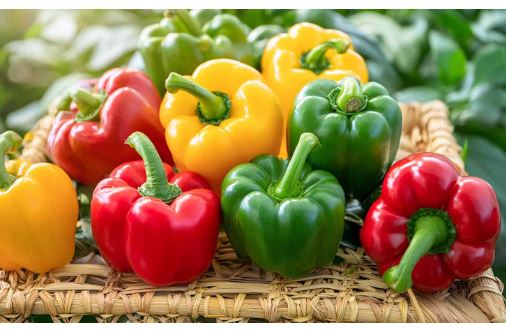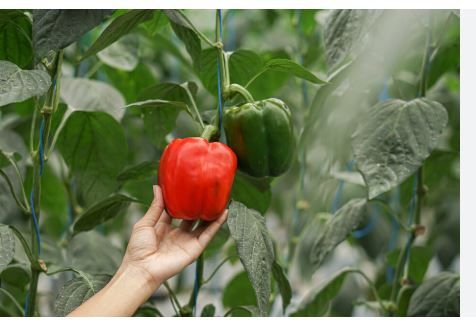
Originating from Central and South America, they were domesticated thousands of years ago before spreading across the globe through exploration and trade. Today, they thrive in warm climates and are cultivated in countless regions of the world.
They come in a variety of vibrant colors and are known for their crisp texture and mild, sweet flavor. These vegetables are often enjoyed both raw and cooked, adding brightness and crunch to a wide range of dishes. Whether chopped into salads, grilled, or stuffed, they bring a refreshing element to meals without overwhelming the palate.
What sets these peppers apart is their lack of heat, a trait that distinguishes them from their fiery cousins in the same botanical family. Instead, they offer a spectrum of tastes, from slightly bitter when unripe to sugary sweet as they mature. This flavor evolution is tied to their ripening process, during which their colors transform, reflecting changes in nutritional content. Rich in vitamins and antioxidants, they’re as nutritious as they are flavorful, making them a favorite in health-conscious diets.
Their shape is usually plump and rounded, with thick walls that make them ideal for holding fillings. Inside, they contain a cluster of seeds attached to a white membrane, which can easily be removed before preparation. The outer skin is smooth and glossy, making them visually appealing and easy to clean.
Nutritionally, they are a rich source of vitamins and antioxidants. Low in calories and high in fiber, they contribute to a balanced diet and support overall health. Their natural sweetness makes them a popular choice for those looking to reduce added sugars in their meals.
They can be enjoyed raw, adding a satisfying crunch to salads and platters, or cooked in countless ways—roasted, grilled, stuffed, or sautéed. Their thick walls hold up well under heat, while their natural sweetness enhances everything from savory stews to vibrant salsas.
In the garden, they thrive in warm, sunny climates and require consistent care to reach full maturity. Once harvested, they can be stored in a refrigerator for several days, retaining their firmness and flavor.

Types of Bell Peppers
Green Bell Pepper
- Origin: Native to Central and South America, cultivated widely after Columbus introduced peppers to Europe in the 15th century.
- Description: Harvested before fully ripening, green bell peppers are immature versions of red, yellow, or orange varieties. They have a thick, crisp flesh with a slightly bitter, grassy flavor.
- Heat: 0 SHU (not spicy).
- Uses: Common in stir-fries, salads, stuffed pepper recipes, and as a pizza topping due to their robust texture and earthy taste.
Red Bell Pepper
- Origin: Same as green bells, but allowed to ripen fully on the plant. Widely grown in the Americas, Europe, and Asia.
- Description: Bright red with a sweet, fruity flavor, red bell peppers are the ripest stage of the green variety. They’re juicier and softer than their green counterparts.
- Heat: 0 SHU.
- Uses: Perfect for roasting, sauces, salsas, and raw in salads. Their sweetness enhances dishes like ratatouille.
Yellow Bell Pepper
- Origin: Developed through selective breeding from early Capsicum annuum varieties, likely in the Americas or Europe.
- Description: Vibrant yellow with a mild, sweet taste. They’re less bitter than green peppers and not as sugary as red ones, striking a pleasant balance.
- Heat: 0 SHU.
- Uses: Great in colorful salads, grilled dishes, or as a garnish. Their bright hue adds visual appeal to recipes.
Orange Bell Pepper
- Origin: A cultivated variety, likely bred in Europe or North America for its striking color.
- Description: Orange bells have a sweet, slightly tangy flavor with crisp, juicy flesh. They’re less common than red or yellow varieties.
- Heat: 0 SHU.
- Uses: Excellent raw in crudités, roasted, or blended into sauces for a subtle sweetness and vivid color.
Purple Bell Pepper
- Origin: A modern cultivar, possibly originating in the Netherlands or the U.S., bred for ornamental and culinary use.
- Description: Deep purple (almost black) exterior with green interior flesh. They have a mild, slightly sweet taste with a crisp texture.
- Heat: 0 SHU.
- Uses: Adds dramatic color to salads, stir-fries, or stuffed dishes. The purple skin fades when cooked.
White Bell Pepper
- Origin: Rare variety, likely developed in Europe (e.g., Hungary or the Netherlands) through selective breeding.
- Description: Pale ivory or off-white with a mild, sweet flavor. They’re thinner-walled and less juicy than other bells.
- Heat: 0 SHU.
- Uses: Used in gourmet dishes, raw platters, or lightly sautéed to preserve their delicate color and taste.
Brown Bell Pepper
- Origin: A lesser-known cultivar, possibly bred in the U.S. or Europe for novelty.
- Description: Chocolate-brown exterior with a sweet, earthy flavor. They’re rare and have a softer texture when ripe.
- Heat: 0 SHU.
- Uses: Ideal for roasting, grilling, or adding an unusual twist to salads and stews.
Black Bell Pepper
- Origin: Likely a modern hybrid from Europe or North America, bred for visual appeal.
- Description: Dark blackish-purple skin with a mild, sweet taste. Similar to purple bells but darker and less common.
- Heat: 0 SHU.
- Uses: Stunning in fresh dishes or as a garnish; color fades with heat, so best used raw.
Mini Bell Pepper
- Origin: Selectively bred from standard bell peppers, popularized in the U.S. and Europe for snacking.
- Description: Small (2-3 inches), available in red, yellow, orange, and sometimes purple. Sweet, crunchy, and seedless or low-seed.
- Heat: 0 SHU.
- Uses: Perfect for snacking, dips, or roasting whole. Often sold in mixed-color packs.
Italian Sweet Bell Pepper (Cubanelle)
- Origin: Originated in the Caribbean or Italy; widely grown in Mediterranean climates.
- Description: Long, tapered shape with light green to red coloring. Mildly sweet with thinner walls than standard bells.
- Heat: 0 SHU.
- Uses: Popular in Italian and Latin American cuisine, fried, stuffed, or in sofrito.
Chocolate Bell Pepper
- Origin: A rare cultivar, possibly from the U.S. or Europe, distinct from brown bells.
- Description: Rich, chocolate-brown with a sweet, slightly smoky flavor. Flesh is tender and aromatic.
- Heat: 0 SHU.
- Uses: Excellent roasted, in sauces, or as a unique salad addition.
Rainbow Bell Pepper (Mixed Hybrids)
- Origin: Modern hybrids from commercial agriculture, often from the Netherlands or California.
- Description: A catch-all term for bell peppers bred for variegated or striped colors (e.g., red with yellow streaks). Sweetness varies by ripeness.
- Heat: 0 SHU.
- Uses: Primarily ornamental but edible; great for raw dishes or Instagram-worthy presentations.
Gypsy Pepper
- Origin: A hybrid developed in the United States, often credited to American breeders.
- Description: Small to medium, elongated bell shape with thin walls. Starts pale green, ripens to yellow, orange, then red. Sweet with a slight tang.
- Heat: 0 SHU.
- Uses: Ideal for frying, grilling, or fresh in salads due to its tender flesh.
- Fun Fact: A favorite in Hungarian-American cuisine, it’s sometimes called a “sweet frying pepper.”
Pimento (Pimiento) Pepper
- Origin: Native to the Americas, popularized in Spain and the Southern U.S.
- Description: Heart-shaped, thick-walled, and bright red when ripe (green when immature). Very sweet and aromatic.
- Heat: 0 SHU.
- Uses: Core ingredient in pimento cheese, stuffed olives, or roasted for sauces.
- Fun Fact: The “pimento” in olives is typically this pepper, canned or jarred.
Lipstick Pepper
- Origin: Bred in North America, likely for home gardening.
- Description: Short, tapered, and glossy; ripens from green to a deep red. Exceptionally sweet with juicy flesh.
- Heat: 0 SHU.
- Uses: Perfect for fresh eating, salsas, or roasting due to its intense sweetness.
- Fun Fact: Named for its vibrant red color, resembling lipstick shades.
Carmen Pepper
- Origin: An Italian hybrid, developed for its unique shape and flavor.
- Description: Long, horn-shaped with a pointed end; ripens from green to bright red. Sweet with a rich, fruity taste.
- Heat: 0 SHU.
- Uses: Excellent roasted, grilled, or in Italian dishes like peperonata.
- Fun Fact: Won an All-America Selections award for its taste and productivity.
Banana Bell Pepper
- Origin: Likely bred in the U.S., distinct from spicy banana peppers.
- Description: Long, slender, and curved; pale yellow when unripe, turning red or orange. Mild and sweet with thin walls.
- Heat: 0 SHU.
- Uses: Often pickled, grilled, or used as a mild substitute in recipes calling for banana peppers.
Corno di Toro (Bull’s Horn) Pepper
- Origin: Traditional Italian heirloom from the Piedmont region.
- Description: Large, elongated, and curved like a bull’s horn; ripens from green to red or yellow. Sweet and meaty.
- Heat: 0 SHU.
- Uses: Stuffed, roasted, or grilled—popular in Mediterranean cooking.
Islander Pepper
- Origin: A modern hybrid, likely from the U.S. or Netherlands.
- Description: Starts lavender-purple, ripens to yellow, orange, then red. Mildly sweet with a crisp bite.
- Heat: 0 SHU.
- Uses: Stunning in salads or as a garnish; color fades when cooked.
Sweet Chocolate Pepper
- Origin: A cultivar from North America, distinct from chocolate bells by shape.
- Description: Medium-sized, blocky shape with a dark brown exterior. Sweet with a hint of smokiness.
- Heat: 0 SHU.
- Uses: Roasted or raw in salads for a unique flavor and color combo.
California Wonder Pepper
- Origin: An American heirloom, introduced in the 1920s by breeders in California.
- Description: Classic blocky bell shape; ripens from green to red. Thick-walled, sweet, and juicy.
- Heat: 0 SHU.
- Uses: The quintessential stuffing pepper, also great raw or cooked.
- Fun Fact: One of the most widely grown bell pepper varieties globally.
Golden Bell Pepper
- Origin: A cultivated strain, possibly from Europe or the U.S.
- Description: Bright golden-yellow when ripe, with a sweet, mellow flavor and firm texture.
- Heat: 0 SHU.
- Uses: Adds sunshine to dishes—roasted, in soups, or fresh in slaws.
- Fun Fact: Sometimes marketed as “Golden California Wonder” as a variant.
Tequila Sunrise Pepper
- Origin: A hybrid from North America, named for its color transition.
- Description: Elongated with thin walls; ripens from green to orange with a golden tip. Sweet and slightly tart.
- Heat: 0 SHU.
- Uses: Great for pickling, grilling, or fresh snacking.
- Fun Fact: Its gradient coloring mimics a tequila sunrise cocktail.
Big Bertha Pepper
- Origin: Developed in the U.S. for commercial and home growers.
- Description: Extra-large, blocky bell; ripens from green to red. Very sweet with thick, crunchy walls.
- Heat: 0 SHU.
- Uses: Ideal for stuffing (holds lots of filling), grilling, or slicing into rings.
- Fun Fact: Can grow up to 7 inches long, making it a giant among bells.
General Notes
- Heat: All bell peppers lack capsaicin, the compound responsible for spiciness in other peppers, making them universally mild (0 SHU).
- Cultivation: Most modern varieties stem from Capsicum annuum domesticated in Mexico over 6,000 years ago, then spread globally.
- Flavor Variation: Ripeness affects sweetness—green bells are less ripe and more bitter, while colored varieties (red, yellow, orange) are fully ripened and sweeter.
- Diversity: Beyond the standard red, yellow, and green bells, many of these varieties are hybrids or heirlooms bred for flavor, size, or aesthetics. Regional preferences (e.g., Italy’s Corno di Toro or Spain’s Pimento) showcase cultural adaptations.
- Heat: All remain at 0 SHU, distinguishing them from spicy Capsicum relatives like jalapeños or habaneros.
- Culinary Role: Their lack of heat and range of sweetness make them staples in global cuisines, from raw snacks to complex cooked dishes.